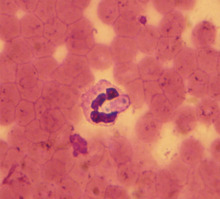Hepatozoidae
| Hepatozoon | |
|---|---|
 |
|
| A gamont of Hepatozoon canis in a blood smear from a naturally infected dog | |
| Scientific classification | |
| Domain: | Eukaryota |
| (unranked): | Sar |
| (unranked): | Alveolata |
| Phylum: | Apicomplexa |
| Class: | Conoidasida |
| Order: | Eucoccidiorida |
| Suborder: | Adeleorina |
| Family: | Hepatozoidae |
| Genus: |
Hepatozoon Miller, 1908 |
| Selected species | |
|
Hepatozoon americanum |
|
Hepatozoon americanum
Hepatozoon atticorae
Hepatozoon ayorgbor
Hepatozoon canis
Hepatozoon cevapii
Hepatozoon cuestensis
Hepatozoon catesbianae
Hepatozoon clamatae
Hepatozoon fasciatae
Hepatozoon lygosomarum
Hepatozoon massardii
Hepatozoon muris
Hepatozoon pictiventris
Hepatozoon punctatus
Hepatozoon sauritus
Hepatozoon seminatrici
Hepatozoon sipedon
Hepatozoon sirtalis
Hepatozoon thomsoni (Minchin, [1908])
Hepatozoon is a genus of Apicomplexa alveolates which incorporates over 300 species obligate intraerythrocytic parasites. Species have been described from all groups of tetrapod vertebrates, as well as a wide range of haematophagous arthropods, which serve as both the vectors and definitive hosts of the parasite. By far the most biodiverse and prevalent of all haemogregarines, the genus is distinguished by its unique reciprocal trophic lifecycle which lacks the salivary transmission between hosts commonly associated with other apicomplexans. While particularly prevalent in amphibians and reptiles, the genus is more well known in veterinary circles for causing a tick-borne disease called hepatozoonosis in some mammals.
Members of the genus Hepatozoon possess particularly complex lifecycles which vary considerably among species. Sexual reproduction and sporogenic development occur within the haemocoel of the invertebrate host, which is subsequently consumed by the vertebrate host. The sporozoites then migrate to the liver of the vertebrate, where they undergo multiple fission (asexual reproduction) to produce merozoites. The meronts are released into the bloodstream where they form , the final stage of development within the vertebrate host. The gamonts are large, conspicuous organisms which occupy a significant portion of the erythrocyte, and are easily visible on simple blood films. When the invertebrate vector feeds on the blood of the infected vertebrate, the gamonts are taken up into the gut once more, where they undergo gametogenesis and the cycle begins once more.
...
Wikipedia
